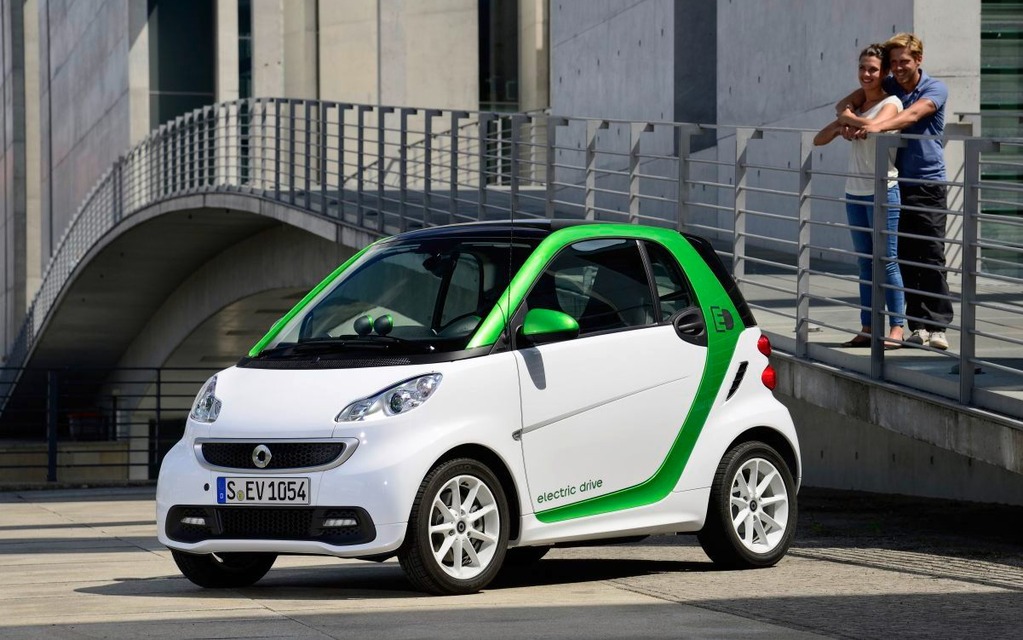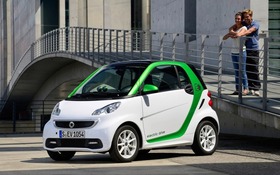2014 smart electric drive: Worry, Wait and Guilt

| Strong points |
|
|---|---|
| Weak points |
|
When the topic turns to electric cars, people are quick to surmise that a battery-powered vehicle can’t possibly be practical in winter. After all, cold temperatures make batteries less efficient and diminish operating range.
That’s the theory, anyway. Personally, I had never had the opportunity to put the theory to the test, so I jumped at the chance to test drive an electric-powered smart this February. (With the temperamental winter that we’ve been having, there’s no time like the present!) When I got behind the wheel, the temperature was a cool -24°C—the conditions couldn’t have been more challenging. I was finally going to be able to do a thorough test drive of an electric car.
- Also: 2013 smart electric: The 3rd generation
- Also: A Long-range Electric Battery Pack Made In Canada
A good idea in theory
Until they invent batteries that let you to travel 300 kilometres or more on a single charge, electric cars will remain short-range vehicles used for short trips. For now, they are first-rate city cars or great second family vehicles for suburbanites to run errands within 50 clicks of home.
It’s lightweight design helps give it an operating range of a little more than 100 km, making the smart ideally suited to this purpose. The manufacturer claims that its range is 145 km in optimal conditions, but you’d be wise to play it safe and plan on about 100-110 km. Note that the engineers dug deep in their bag of tricks to reduce energy consumption as much as possible.
Unlike the first generation, performance is decent. It gets from 0-100 km/h in 11 seconds and has a maximum speed of 125 km/h—not half-bad for a microcar with an electric motor. In town, performance is respectable, as it goes from 0-60 km/h in less than five seconds, which helps you keep up with the flow of traffic and even pull ahead of it from time to time. But those numbers are all for ideal conditions, so let’s see what happens once the mercury plunges towards the bottom of the thermometer.
Consistent and nerve-racking
When I took possession of my electric smart, the first thing that I noticed was that this car is much more pleasant to drive than its counterpart with the conventional combustion engine. Unburdened by the listless, slow, jerky shifting of the gas-powered version’s gearbox, its one-speed transmission gives it linear accelerations and good pick-up. What’s more, the steering seemed more precise with the electric version.
Unfortunately, I didn’t really have the time to appreciate the ride after glancing at the battery charge and operating range gauge—it was melting like ice in the sun! However, my driving was 100% green according to the indicator on the dashboard.
My operating range plummeted from 110 to 38 km after a trip from the Mercedes-Benz regional office on Saint-Jean Boulevard in the West Island to the TVA building on De Maisonneuve Boulevard. In concrete terms, it means that a trip of approximately 32 kilometres used up the equivalent of 78 kilometres! Even more worrisome was that I was still 20 kilometres away from home.
I left three hours later, after shooting the Guide de l’auto television show at MAtv. Despite the long wait in the intense cold, the operating range was still 38 kilometres, which I considered a small victory. Upon arrival at home, my anxiety about running out of juice abated and the gauge indicated that I could go another 18 kilometres before the battery ran out of power. But my troubles were only beginning...
Outlet, doorbell, telephone
Wanting to see if the battery was going to lose power, I decided not to plug the car in right away. Later that evening, I went to plug it in and discovered that the cord wasn’t long enough! So, I went to my neighbour’s place to ask if I could use his outside electrical outlet. (With this car, no extension cords are allowed.) I parked my little wonder a few feet from his wall and returned home confident that the battery would be recharged the next morning.
As dawn broke, I hurried to check if the battery was charged. Still bitterly cold, getting into the car was like getting into a refrigerator. To my great frustration, the battery was not recharged. In fact, the operating range was at a mere 8 kilometres. I studied the owner’s manual and tried to make sense of its terribly vague instructions. I called the dealership and spoke to a technician, and we went over the steps for plugging it in and for battery management. We concluded that I hadn’t done anything wrong; everything should be working.
I went back to my office and left my little wonder plugged in, without verifying if the plug was switched on.
Platform and guilt
Basically, the smart electric remained plugged in for three hours and nothing happened: the battery simply refused to charge. Since an operating range of eight kilometres was not enough to go anywhere, I enlisted the help of Mercedes-Benz emergency roadside assistance. The smart went back to the dealership on a platform. Imagine my humiliation as an automobile journalist to be unable to figure out the battery!
I felt guilty and thought I had damaged the battery by not plugging it in immediately upon arrival at home. Luckily, that wasn’t the case at all. Once at the dealership, the car was kept indoors where it was warm and toasty for some time before it was plugged in. The battery recovered and was fully charged a few hours later.
This stressful, aborted test drive convinced me that electric cars and Arctic cold do not mix, that you practically need a heated garage and that you can’t wait too long to plug it in once you get to your destination, especially in winter. If I remember correctly, the technician said that the system that keeps the battery warm is effective for a maximum of four hours before it runs out of power. I’ll keep that in mind for next time.
In the meantime, I learned a lot about how electric cars behave in winter and discovered a smart that is much more pleasant to drive. Unfortunately, Mother Nature sabotaged my test drive.











